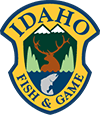Elk
HABITAT
Sagebrush-covered deserts, aspen draws above farm fields, high mountain meadows, or thick timbered ridges.
TASTE
Lean, tender meat that tastes similar to beef. Excellent table fare.
ABUNDANCE
Excellent populations.
LICENSE, TAGS AND PERMITS NEEDED
Valid Idaho hunting license and elk tag. Archery permit if hunting in archery only season. Muzzleloader permit if hunting in muzzleloader only season.
HABITAT
Idaho’s diversity and abundance of big game species is rarely rivaled, and Rocky Mountain elk are considered by many hunters to be the state’s premier big game animal. Elk provide an incredible mixture of recreational, aesthetic, social, cultural, economic, and scientific value to people who work or live in, or visit Idaho. Thanks to Idaho’s diverse habitats and a population of approximately 107,000 elk, Idaho elk hunters can pursue their quarry in sagebrush-covered deserts, aspen draws above farm fields, high mountain meadows, or thick timbered ridges. In fact, elk are found in all of the 99 Game Management Units (GMU) within the state, and elk hunting is provided in 98 GMUs. Because elk are so widespread and abundant, Idaho elk hunters are fortunate to have a diversity of hunting experiences and opportunities available to them. The average hunter density in the majority of Idaho’s elk management zones is less than 1.5 hunters per mile.
HISTORICAL PERSPECTIVE
Historically, elk numbers in Idaho were likely lower than they are today. Accounts from the Lewis and Clark expedition and trappers during the height of the fur trade generally suggest elk populations were scattered and only locally abundant in northern Idaho. Eastern Idaho elk populations appeared robust in the mid-1800s. Statewide, populations were most likely reduced during the unregulated hunting of the late 1800s and early 1900s. Ungulates, including elk, were heavily utilized for food by miners, trappers, loggers, and other settlers.
EARLY 1900s
European settlement brought changes to the landscape. Millions of sheep, cattle, and horses were brought into southern Idaho. Black bear (Ursus americanus) and mountain lion populations generally received little or no protection and gray wolves were functionally extirpated by the early 1900s. In southern and parts of central Idaho, extreme overgrazing combined with fire suppression efforts turned what was primarily perennial grass ranges into shrubfields. Unregulated harvest and conversion of grass dominated ranges to shrubfields likely resulted in fewer elk in southern Idaho.Similarly, landscape-level changes occurred in northern Idaho during the early 1900s. However, the impact was likely more positive for elk habitat and populations. Extensive wildfires created a mosaic of grass, shrubfields, and forested habitats. Nearly extirpated local elk populations were augmented with elk from Yellowstone National Park (YNP) following the large wildfires. Timber harvest also contributed to moving large portions of the forested landscape back towards a more early seral condition. Under these conditions elk flourished in northern Idaho.
MID 1900s
In north-central Idaho, elk populations probably peaked in the 1960s. As the newly created seral habitats aged and succession continued to move towards a climax state, habitat potential declined. Fire suppression efforts resulted in forest habitat advancing to later seral stages 8 Idaho Department of Fish & Game Idaho Elk Management Plan and preventing natural regeneration of early seral stages more favorable to elk.By the 1970s, hunter numbers and access had increased to the point where restrictive seasons were necessary to reduce elk vulnerability to harvest. Either-sex bag limits throughout most of Idaho were replaced by antlered-only bag limits in 1976. Elk populations responded, and by the late 1980s elk were once again abundant enough to support more liberal antlerless opportunity. Predator populations were likely reduced or suppressed during the mid-1900s, but had some localized effects on elk in remote areas.
LATE 1900s
In portions of northern Idaho, the mid-1990s witnessed another downward cycle in elk numbers. Declining habitat potential in forested habitat, black bear and mountain lion predation, and the localized impacts of hard winters (1996 and 1997) all played a role. With protection and harvest restrictions implemented during the 1970-1990s, black bear and mountain lion populations likely stabilized and began to flourish, particularly in central mountain areas (commonly referred to as backcountry) where hunting access is difficult. Wolves became reestablished in Idaho during the 1990s through USFWS reintroduction, and through wolves from southern Canada and northwest Montana naturally re-occupying historic wolf habitat. Wolf predation on elk has further accelerated declines in elk herds in many parts of northern Idaho.In other portions of the state, including much of southern Idaho, elk numbers actually increased during this same timeframe. A change in grazing practices that promoted grass production, farming practices that favored resting farmland, and continued timber cuts that favored early seral habitat stages all enabled southern Idaho elk populations to grow to all-time record highs during the latter half of the 1900s.
TODAY
Elk herds in the southern part of the state are mostly robust and limited more by sociological constraints, such as damage to agricultural crops and property, than by habitat suitability. Average hunter density by elk management zone in Idaho, 2009-2011. Idaho Department of Fish & Game Introduction 9 Elk herds in the central and northern mountains continue to be suppressed by predators and habitat declines. Elk herds in the prairies and agricultural areas of northern Idaho are mostly robust and population levels are constrained by crop and property damage. In total, Idaho’s elk population in early 2013 was estimated at approximately 107,000 animals. Elk will always be a high priority species relative to their impact on hunting and other recreational opportunities, cultural heritage, and rural economies, and elk management is a priority program for IDFG.

